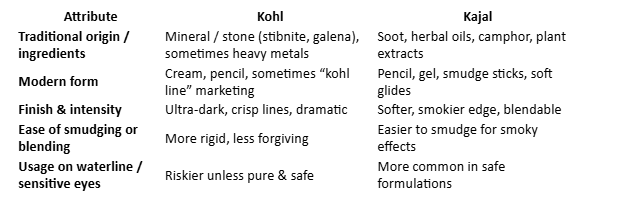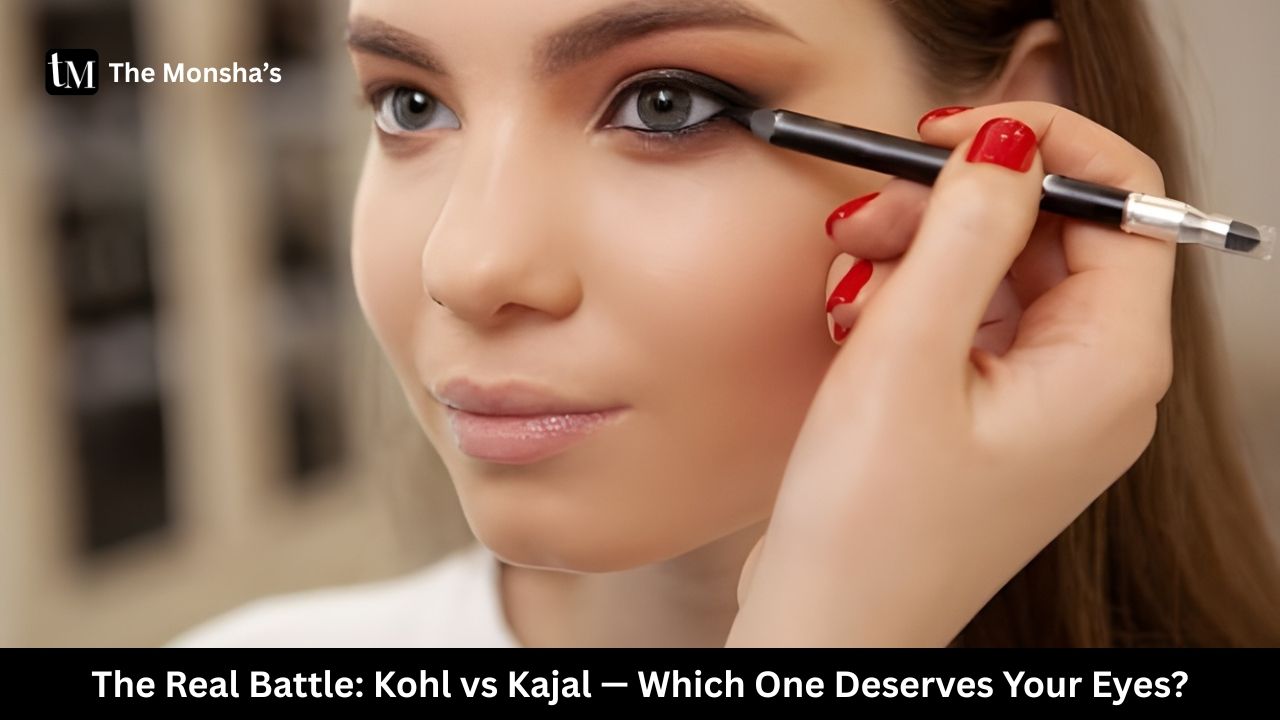TL;DR
Kohl and kajal are often used interchangeably, but they differ in origin, formulation, and safety. Traditional kohl can carry risks (lead, heavy metals), whereas good kajal (modern, regulated) is safer and more suited for daily wear. Use the table, tips, and FAQ below to choose wisely and slay your eye game. 👁️
A Bit of History & Cultural Charm
Before you sharpen your pencil, let’s go back in time (yes, I’m tired, but this is fun).
- Kohl has roots in ancient Egypt, the Middle East, and across Africa. It was used not just for beauty but for eye protection against sun, dust, and for ritual purposes. Over centuries, formulas varied: stibnite, antimony sulfide, even lead compounds.
- In India, kajal became a local adaptation— soot, herbal oils, camphor—as both cosmetic and “protective” tradition (for babies, women, warding off nazar). The term “kajal” took on a softer, more accessible meaning in many households.
- Over time, terminology blurred: what one person calls “kohl” might really be kajal, and vice versa.
So when you ask “Which one is better?” — the answer depends on which version you’re using.
What is Kohl, Really?
Traditional Kohl Formulas & Significance
- Pure, old-school kohl was often mineral based: crushed stones like stibnite or galena (lead sulfide).
- Its ultra-dark pigment gave intense, dramatic lines. In some cultures it was more than makeup — medicine, belief, identity.
Modern Interpretations (and Risks)
- Many modern “kohl” products don’t use the ancient lead or antimony formulas; instead they mimic the look with safe pigments and waxes.
- But here’s the catch: some do still contain lead or heavy metals. Research measuring lead in kohl samples reveals detectable, sometimes high levels.
- In fact, regulatory bodies (like the FDA) caution against kohl (and related names) because of lead poisoning risks, and classify many of them as illegal color additives when containing unsafe components.
So, if someone sells “pure kohl” from an unknown source, your inner skeptic should be awake.
What is Kajal, Really?
Traditional / Local Kajal
- Kajal is classically made from soot (lamp black), almond oil, camphor, herbal extracts. The result is softer, more blendable.
- It was (and is) common in Indian households, often made at home, sometimes used on infants’ eyes (though that is controversial).
- The traditional version leans less “bold line” and more “soft smoky edge.”
Commercial & Modern Kajal
- Brands now produce kajal sticks, gel kajal, smudge kajal — using safer pigment bases, waxes, smooth gliders.
- Many modern kajal formulations are dermatologically tested, labeled non-comedogenic, and avoid heavy metals.
- These versions are generally more suited to regular wear, waterline use (if dye approval is safe), and gentler on sensitive eyes.
Kohl vs Kajal — Side-by-Side Table


This table gives you a quick glance — but always read the label.
How to Choose (Your Eyes Will Thank You)
Here’s how to pick smart:
- Read the ingredients — avoid “lead sulfide,” “galena,” “antimony,” “unlisted pigments.”
- Look for certification / lab test transparency — some brands publish heavy metal tests.
- Test on sensitive skin first — apply to outer lower lash line, wait 24 hours.
- Know your use case — if you want drama for a party, a safe “kohl look” is fine; for daily wear, go with gentler kajal.
- Avoid home-made “traditional” formulas with ambiguous ingredients — it’s tempting, but you don’t want eye damage.
Also, a user on Reddit warned:
“Traditional kajal has… a lot of lead. I’m very cautious. Always check brands.”
Best Practices for Application & Removal
You’ve chosen your weapon — now don’t ruin your eyes.
Application Tips
- Clean lids, pat them dry (no oil).
- Warm the tip slightly (rub with finger) so it glides.
- Apply in light strokes; build gradually.
- Smudge the edges if you want smokiness.
- Avoid dragging hard — sensitive eyelids don’t deserve that.
Removal Ritual
- Use a mild oil-based eye makeup remover or micellar water.
- Gently press and let makeup dissolve — don’t scrub.
- Follow with a gentle cleanser.
- Never sleep with kajal/kohl on — that’s just asking for trouble (infections, clogging).
Also, hygiene is non-negotiable:
- Don’t share eyeliners.
- Sharpen pencils cleanly, discard dried ones.
- Don’t apply makeup on moving vehicles — even bumping can damage your cornea.
Safety & Health Risks — What You Must Know
This is the serious part (I sat up for this one).
- Traditional kohl, kajal, surma have been found to contain lead, which is toxic and especially harmful to children, pregnant women, and developing brains.
- One study measured lead (Pb) in many kohl samples, confirming non-trivial levels.
- The FDA warns that kohl, kajal, al-kahal, surma etc. are considered illegal color additives if they contain unsafe pigments — meaning many traditional formulas are not allowed.
- Eye cosmetic misuse or contamination can lead to infections, corneal injury, or worse.
In short: no matter how “traditional” or “heritage” a product is, safety matters.
Trends, Innovations & Clean Beauty Moves
Because even my tired heart loves new launches:
- Vegan / cruelty-free kajal / “kohl look” hybrids — using plant-based carbon, iron oxides, clean pigments.
- Waterline-safe formulas — some brands now label “safe for waterline” (if verified).
- Colorful kajal & kohl — jewel tones, charcoal blues — but check that pigments are safe for eyes.
- Minimalist / hybrid liners — one stick that can do crisp line and smoky blend.
In India, many indie brands are surfacing claiming “lead-free”, “lab-certified”, “Ayurvedic ingredients.” Always ask for tests before believing the hype.
FAQs — Because You’re Thinking of Them
Q: Can I use kohl on my waterline?
Technically yes only if the formula is certified safe and meant for that use. Many traditional kohls are too harsh for waterline use.
Q: Is kajal always safer than kohl?
Not always — a “kajal” with unverified pigments can be just as risky. The difference lies in ingredients and regulation, not just the name.
Q: What about homemade kajal or family recipes?
Dangerous. Unless you have the tools to test for heavy metals, it’s risky. I know “Nani’s kajal” has legacy, but your eyes deserve lab-tested safety.
Q: Can I layer kajal and kohl together?
Yes — e.g. a safe dark kajal underneath and sharp “kohl look” over it — but only if both are safe. Don’t mix “random old kohl” over your good kajal.
Q: How often should I replace my kajal/kohl pencil?
Every few months. Once it dries, deteriorates, or becomes crumbly — toss it. Old eye products are bacterial playgrounds.
Final Thoughts (From a Beauty-Writer Who’s Half Asleep)
Kohl vs kajal is not a battle of superiority — it’s a matter of awareness, ingredients, and your eyes’ tolerance. Use the comparisons, table, and safety rules above to decide what suits you best.
If someone says “I only use pure kohl from my ancestors” — ask for the ingredient test. Because “tradition” is lovely — but not at the cost of your eyesight.


